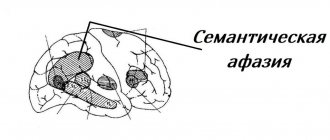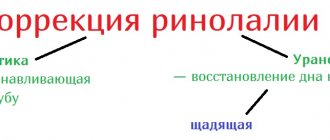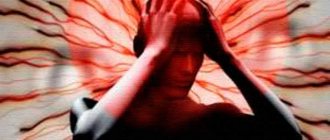Article:
For speech impairments associated with auditory-verbal memory disorders, doctors make a diagnosis of “Acoustic-mnestic aphasia.” The pathology is characterized by difficulty repeating combinations of words, as well as difficulties in selecting specific words. To make a diagnosis, speech therapy examination, magnetic resonance imaging and other methods of laboratory and instrumental diagnostics are used. Correction of acoustic-mnestic aphasia requires an integrated approach - eliminating the immediate cause, classes with a speech therapist and the use of medications.
general information
Aphasia is the most common complication of strokes and other brain lesions. According to statistics from the World Health Organization, 30% of people with speech disorders are of working age. Moreover, 80% of them are disabled due to speech impairments.
The acoustic-mnestic type of pathology was identified by A. Luria. He noted that patients retain the ability to repeat individual words and understand them, however, when writing from dictation or when communicating with long sentences, patients begin to make mistakes.
The disease is accompanied by impaired auditory-verbal memory and a decrease in the volume of acoustic perception. Patients with such disorders remain critical of their condition and complain that during a conversation they do not understand well what they hear, and they themselves have difficulty finding words.
Restorative training: correction of speech understanding in aphasia, video
People around and relatives should remember the mental state of the patient, who, due to a long-term inability to maintain contact with the environment, may experience despondency and even depression. Aphasics are aware of their disability, they are sensitive to environmental reactions. A lot of tact and patience is needed, both from the speech therapist and from the immediate environment, otherwise correction in the work of speech understanding will be ineffective. It is better to take a break from therapy than to discourage the patient by rushing it.
Speech therapy and rehabilitation education should be tailored to the nature of speech disorders and their severity. Direct methods involve performing the damaged function to utilize the reserves present in the damaged area if it has not been completely damaged. When these methods do not produce results, indirect methods are used, which involve the inclusion of additional replacement functions. For example:
- In case of sensory disturbance of the position of the organs of speech, the patient can use his vision.
- It is enough to show him diagrams of the position of the speech organs corresponding to certain sounds, and there will be a gradual recovery.
It is impossible to follow a fixed therapeutic program, since there is a wide variety of symptoms, and even within the same form of aphasia it is necessary to adapt the program to the following factors:
- Type of speech disorders
- The physical and mental capabilities of the patient
- His age, education and interests
Therefore, it is important that a speech therapist works with the patient, who will help achieve good results faster.
Worth knowing: Young people learn speech much faster than older people. The best results are achieved with educated people who understand the need for re-education and are aware of their speech difficulties.
Below you will find a series of videos in which a specialist explains how to deal with sick people. We can say with confidence that a speech therapist will help quickly and productively restore speech abilities after a stroke, injury and other conditions.
Reasons for development
Neurologists know well what underlies acoustic-mnestic aphasia. The pathology is characterized by the appearance of a lesion in the region of the mid-posterior sections of the anterior temporal gyrus in the cerebral cortex. The damage is localized in the dominant hemisphere - in the left in right-handers, and in the right in left-handers. The defeat is organic in nature:
- With the growth of intracerebral benign and malignant tumors, as well as metastatic foci, the nervous tissue is compressed or directly destroyed by the tumor.
- An ischemic stroke leads to the death of an area of the cerebral cortex as a result of a sharp decrease in blood flow. Hemorrhagic stroke is accompanied by the development of hemorrhage, which leads to compression of the nervous tissue.
- The occurrence of traumatic brain injuries is accompanied by bruising or crushing of brain tissue, as well as the formation of hematomas. This can cause damage or death to nerve cells located in the anterior temporal gyrus.
- Degenerative diseases that tend to constantly progress (Pick's disease, Alzheimer's disease, etc.) lead to local death of neurons, leading to impairment of many cognitive functions, including speech.
- Neuroinfections, primarily encephalitis, lead to the formation of an inflammatory focus in the cerebral cortex. Neurons in the area of inflammation are damaged and die.
The main mechanism of acoustic-mnestic aphasia is damage to the specified area of the temporal gyrus. This nerve center is responsible for choosing words during a conversation. Clinically, this leads to impairment of auditory-verbal memory - its volume decreases and the person begins to forget words. In addition to speech, counting, reading and writing suffer. If the damage is extensive, the posterior parts of the temporal gyri may suffer. As a result, the functioning of optical-gnostic structures is disrupted. Patients cannot compare the visual image of an object and its verbal designation. In this case, speech loses its meaning.
Aphasia - speech disorders in the brain: features of therapy
In some aphasics, speech disorders in the brain recede to some extent spontaneously, without speech therapy. This occurs in situations where, in addition to permanent damage to certain areas of the brain, temporary damage has occurred, caused, for example, by edema, circulatory disorders or decreased excitability of nerve cells and synaptic conductivity. Features of aphasia therapy:
- Permanent, organic damage to the brain causes impairment of certain functions. In this case, therapy consists of replacing the function with a function that can participate in a given functional system, for example, sensation or auditory-visual perception.
- Speech therapy can begin only when the acute symptoms of the disease that caused the aphasia subside.
- At first, sessions should be short (under 5 minutes).
- The time of re-education can be gradually increased, but - depending on the patient's mood - short but frequent breaks for rest should be taken.
- At the next stage, exercises can last up to 45 minutes a day with a frequency of 3-4 times a week or even every day.
Worth knowing: In milder cases, speech returns within 1-3 months , often even spontaneously.
For more severe strokes, the help of a speech therapist is required; retraining lasts up to 2-3 years , and speech may not reach its former perfection. It will be slow, simplistic in style, and may remain somewhat difficult to understand.
Clinical manifestations
A distinctive feature of acoustic-mnestic aphasia is the inability of a person to repeat a series of words heard, while maintaining the ability to pronounce them separately. Limitation in auditory-verbal memory leads to the fact that, having heard a chain of words, the patient is able to pronounce only individual words, most often the last ones. Repeated listening to a verbal chain does not lead to improved memorization. This makes it impossible to communicate with several people at the same time, and also impairs the perception of complex sentences consisting of a large number of words. If an instruction is read to a patient with aphasia, he will be able to follow the sequence, but will not be able to repeat what he heard.
During his own speech, the patient cannot quickly select words. Paraphasia occurs - the use of verbal substitutions that are not equivalent in meaning. During a speech therapy examination, agrammatisms associated with the inconsistency of individual words with each other are determined. If you ask the patient to describe thoughts or images, the story will be abrupt and difficult for him.
Dysgraphia has a number of features and manifests itself when writing from dictation. The number of agrammatisms is increasing. While writing, the patient constantly tries to repeat heard fragments in order to facilitate their writing. However, memory is limited to 2-3 words. Dyslexia is less common. It can only be identified when reading long sentences with a complex syntactic structure. Impaired fixation of read information causes a lack of understanding of its meaning and the inability to retell the text. Counting violations are detected in a small percentage of cases.
Emotional and volitional disorders also occur: mood lability, constant anxiety and “fussiness” are noted. With an extensive lesion, clinical manifestations may affect other areas of the patient’s personality.
Aphasia and alalia: speech and perception disorders in children
Aphasia and alalia
Aphasia can also affect children who have suffered accidents or infectious diseases, such as:
- Measles
- Smallpox
- Whooping cough
- Flu
- Diphtheria
- Typhoid fever
- Typhoid fever
- Polio
- Meningitis
In addition to toxic brain damage, influenza and whooping cough can cause cerebral hemorrhages. There is not only a violation of speech, but also the perception of the world as a whole.
Since damage to cortical nervous structures in children occurs during a period of incomplete psychophysical development, symptoms are not as varied as in adults. Speech disorders depend on the following factors:
- Child's age
- Stages of his speech development
- Degrees of reading and writing skills
Thanks to wider possibilities for compensation in the form of new functional systems, aphasia in children recovers faster than in adults. However, some traces of the defect remain both in the speech and in the child’s psyche, since the baby develops in unfavorable conditions. Worth knowing:
- If the cortical structures are damaged before the child begins to speak, this is not aphasia, but alalia.
- Distinguishing aphasia from alalia can be difficult and requires a thorough history and neurological examination, and sometimes longer speech therapy monitoring of the child.
The difference between aphasia and alalia, also called speech impotence, hearing loss (audimutitas), is that alalia occurs before speech development. It is usually characterized by:
- Sufficient mental development
- Good mobility of speech organs
- Normal physiological hearing
But the child does not speak at all, uses gestures, screams and onomatopoeia or a few words from his own vocabulary, understandable only to those close to him. The child also cannot repeat. Such speech impotence can last up to 7 years (simple alalia) and even up to 14 years (complex alalia). As the older child learns more and more words, the pronunciation may become more and more correct. Alalia, like other speech defects and disorders, occurs more often in boys than in girls.
How does a child with aphasia and alalia perceive the world?
- It is sometimes difficult to make friends with such children; they can be inhibited or overexcited.
- Some of them are harmful and aggressive towards younger and weaker children, others avoid contact with the environment.
- It happens that parents are unfair to their children and do not think about difficulties. It is difficult for them to imagine that a child cannot utter a single simple word.
- They constantly think that the child is stubborn and punish him. This causes the baby, which is normal in such a situation, to have a defensive reaction in the form of crying, aggression or malicious actions.
Remember: In such a situation, when parents cannot communicate with their children, when their children do not respond to questions and statements addressed to them, parents should not use punishment. In these cases, it is necessary to observe the child calmly.
Deficiencies in speech understanding are often compensated for in such children by good visual perception and good memory of place. The child maintains contact with his environment through gestures and facial expressions. Sometimes he automatically repeats a word he hears, without understanding its meaning. When this happens, the child needs to contact a speech therapist who knows how to help the baby.
Read another article on our website that describes educational games for children 5 years old for the development of speech, attention, and perception of the world .
Diagnostic measures
Diagnosis of acoustic-mnestic aphasia requires a comprehensive examination with consultations of a neurologist, psychiatrist, speech therapist and other specialists. It is important to understand that these disorders are usually referred to as a “syndrome”, since its development may be based on various reasons. To identify them, the following approaches are used:
- An examination by a neurologist makes it possible to identify concomitant neurological symptoms: paresis and paralysis, sensory disturbances, etc. The cognitive sphere of a person is separately assessed - memory, ability to concentrate, etc. In case of disturbances in the mental state, a consultation with a psychiatrist is necessary.
- A speech therapy examination is carried out by a speech therapist or aphasiologist. Diagnostic signs of acoustic-mnestic aphasia are paraphasia, frequent agrammatisms, a decrease in the volume of auditory-verbal memory, and the absence of disorders of the articulatory apparatus and phonetics.
- Magnetic resonance imaging (MRI) of the brain is necessary to identify the primary cause of the pathology. MRI allows you to identify foci of tumor growth, inflammatory reaction, degenerative changes, areas with ischemia or hemorrhages.
- Lumbar puncture is performed if a neuroinfection is suspected. The resulting cerebrospinal fluid is used to identify a specific type of pathogen using PCR or ELISA diagnostics.
- Doppler ultrasound and MR angiography are used to detect cerebrovascular disorders. These methods are necessary to determine the speed of blood flow in vessels, identify blood clots, arterial stenosis and other disorders.
Differential diagnosis is carried out with other pathologies that are characterized by speech disorders. Acoustic-mnestic aphasia occurs when the temporal cortex is damaged, as a result of which the patient’s articulation and phonetics do not suffer. The characteristics of the mnestic form of pathology are associated with the absence of paraphasias and completeness of statements.
Motor aphasia
- The motor group includes various forms of aphasia, which are united by the main characteristic of this type of disorder - the absence of active oral speech.
- Efferent - a disorder of articulation in which a person cannot freely move from one sound to another. This type of pathology is characterized by uncontrolled speech, which may consist solely of a random set of sounds and words. Speech becomes scarce, patients may not use prepositions and always use the same case. In severe cases, the ability to read aloud is lost.
- Afferent - a violation of articulation, in which a person cannot determine what needs to be done to pronounce a particular sound. Patients confuse sounds that are similar in pronunciation (“z” and “s”, “b” and “p”, etc.), and during speech they can rearrange or skip letters, syllables or words.
- Dynamic - symptoms include a “telegraphic” style of speech, long pauses between words, lack of prepositions, disruption of the usual rhythm, blurred articulation, involuntary transition to a whisper. Typically, patients have reduced speech activity, as if they do not want to engage in dialogue.
Different types of aphasia rarely occur separately from each other; usually the disease has a mixed form. One of its varieties is total, characterized by a complete loss of the ability to speak and understand speech.
Treatment approaches
Effective therapy is based on eliminating the immediate cause of the development of speech disorder. If a tumor lesion or intracranial hematoma is detected, treatment is carried out with neurosurgery, radiation or chemotherapy. Neuroinfections are eliminated using antifungal, antibacterial or antiviral drugs. Strokes are subject to thrombolytic or hemostatic treatment.
Correction of speech disorders is based on:
- Regular speech therapy sessions
They are carried out to increase the volume of auditory-verbal memory. They must be started immediately after the onset of the disease, without delaying a visit to a speech therapist for the rehabilitation period. Initially, exercises with visual perception of an object are used, which makes them easier to remember. Next, the specialist complicates the lessons - the patient writes simple dictations by ear, learns fragments of sentences, word chains, songs and poems. To improve expressive speech, active work is being carried out to clarify the meaning of words and systematize them into separate groups.
In parallel with the treatment of the main pathology, rehabilitation measures begin with the patient. An important part of therapy is communication with medical staff, speech therapist and loved ones. As a result of constant verbal contact and speech therapy exercises, auditory-verbal memory is restored. In addition, patients are advised to exercise therapy, massage and visit a psychotherapist.
Aphasia and apraxia: mechanisms
Aphasia
Apraxia is a violation of purposeful movements and actions while the elementary movements that constitute them are preserved. These two conditions can occur together. The mechanism is like this:
- When the lower parts of the postcentral gyrus of the dominant hemisphere are damaged, oral apraxia develops.
- Usually in combination with motor aphasia: the patient cannot find the positions of the speech apparatus necessary to pronounce the corresponding sounds, sounds that are close in articulation are mixed, and writing is impaired.
- When the frontal lobe is damaged, frontal apraxia occurs: the breakdown of complex movement skills and action programs.
- The patient is prone to echopraxia (repeats the movements of the examiner) or to stereotypical movements that he does not notice.
Such cases are very complex and therefore the intervention and help of a specialist is simply necessary. It is important to follow all the recommendations of the speech therapist and neurologist. The prognosis for treatment is usually good if the disturbances did not occur during inoperable tumor processes or progressive degenerative diseases. Prevention of cardiovascular diseases, head injuries, infections, and various carcinogenic effects is also important.
Possible complications
Acoustic-mnestic aphasia leads to impairment of auditory-verbal memory. A speech defect is accompanied by a deterioration in a person’s socialization - he has difficulty communicating with people around him, and cannot read, write or count. This gradually reduces the level of quality of life, leading to the formation of persistent depression.
The pathology is often accompanied by a neurological deficit, which intensifies the patient’s own feelings of inferiority. Many patients are diagnosed with disability. It is important to note that acoustic-mnestic aphasia is not a cognitive disorder. Thinking and other brain functions are completely preserved. In the absence of treatment, speech dysfunction becomes persistent and difficult to correct in the future.
Prevention of violations
Preventive measures are aimed at the primary prevention of diseases that can lead to speech disorders. Neurologists make a number of general recommendations:
- use protective helmets during professional activities and some sports;
- if you have diseases of the internal organs, for example, diabetes mellitus or atherosclerosis, promptly seek medical help and follow the instructions of your doctor;
- follow the principles of a healthy diet: give up fast food, fried or smoked foods, add fruits, vegetables, lean meat and other healthy foods to your diet;
- regularly engage in sports - cardio training and exercises in the gym;
- Avoid drinking alcohol and smoking.
If you experience difficulty finding words or other symptoms, you should immediately seek medical help.
Forecast
The outcome of the disease is determined by the timeliness of its detection, the severity of the primary brain lesion and the adequacy of the therapy. With the development of acoustic-mnestic aphasia against the background of ischemic stroke, traumatic brain injury or encephalitis and early initiation of treatment, speech function can be completely restored. With chronic brain damage against the background of transient ischemia or neurodegenerative diseases, aphasia develops slowly, often unnoticed by the person, leading to the development of a permanent defect.
The worst prognosis is for tumor damage to the structures of the central nervous system. Complex neurosurgical interventions with chemotherapy and radiation are rarely organ-preserving in nature. The speech defect in such patients persists for a long time.








